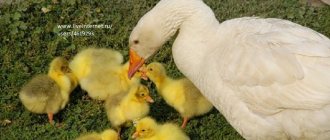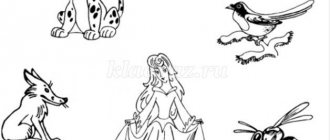Speech therapy classes
— a section with notes on group, frontal, individual speech therapy and logorhythmic classes, as well as integrated classes, master classes on non-traditional teaching methods. We are confident that the materials posted here will be interesting and informative not only for specialists in children's educational institutions, but also for parents who show a sincere interest in the development of their child.
Experienced specialists share their knowledge here, and for beginning speech therapists, the presented notes will help them plan their classes correctly and in a fun way.
Classes with a speech therapist. Materials and notes.
Contained in sections:
- The work of a speech therapist. Speech therapy 8289
Includes sections:
- Differentiation and automation of sounds 4051
By groups:
- Senior group
- Preparatory group
- Middle group
- Junior group
Showing publications 1-10 of 9447. All sections | Speech therapy classes
New
Photo
The best
Consultation for educators “Organization and conduct of physical education classes with elements of logorhythmics in a preschool educational institution” Organization and conduct of physical education classes with elements of logorhythmics in a preschool educational institution Specialists studying children with general speech underdevelopment (R.E. Levina, G.V. Chirkina, T.B. Filicheva and others note the need for an integrated approach to the education and upbringing of children with speech pathology...
Technological map of a speech therapy lesson with elements of experimental activities in a preparatory group Abstract to the technological map of a speech therapy lesson in a compensatory group preparatory to school for children with STD. The development of speech and thinking are interconnected. Speech is a form of communication between people, characterized as a process of reception, processing and...
Summary of a group speech therapy lesson for older children. Topic: “Sound [С], [Сь].”
Summary of a group speech therapy lesson for older children.
Topic: “ Sound [С] , [Сь]”.
Target:
Teach
children to distinguish between the sounds [s] and [s]
;
strengthening the correct articulation and pronunciation of sounds [s] , [s].
Tasks :
Correctional and educational: Practice differentiating sounds
by hardness - softness based on visual, auditory and kinesthetic sensations;
learn to determine the place of sound in a word
, do
a sound analysis of words
, determine the number
of syllables
in a word and their order, lay out a diagram;
Correctional and developmental: develop coherent speech, general and fine motor skills, visual coordination, attention, memory, thinking.
Correctional and educational: developing skills of independence and initiative.
Equipment:
cards with the letter
“C”
, cards in blue, green, red, pictures with animals and objects, a ball.
Progress:
1. Organizational moment:
Speech therapist
:
- Guys, I'm glad to see you! Hello! Let's remember the speech rules that help us control our speech. (repeat speech rules, speech therapist’s voice is calm
, the conversation proceeds with the movement of the hand, from top to bottom, repetition begins with inhalation)
- Well done! Let's move on to breathing exercises ( "Ball"
,
“Let's blow on a snowflake”
,
“Singing vowels” (A, O, U, I)
.
- Okay, now let’s do articulation gymnastics ( “Brushing our teeth”
(mouth open and closed,
“Rock”
,
“Window”, “Clock”
,
“Horse”
,
“
Mushroom ”
, great, you’re doing great. Let’s play puppet theater
(facial gymnastics)
.
- Very good, now let’s do some relaxation (children lie down on the carpet, teacher - speech therapist
read a relaxing verse).
2. Main part:
Speech therapist
:
- Well done. Go to the chairs. Look who it is? ( speech therapist
shows the picture “Elephant”).
That's right, elephant. (pronounce the word, emphasizing the sound [C] )
What is the first
sound in this word
?
([C], shows a picture with the letter [C], and what kind of sound is it, hard or soft
? When we pronounce this
sound
, do we
“smile”
or not? (if it’s hard
don’t smile
; if it’s soft,
we smile
). Correct. this
sound is hard
, what color will we use to denote it
(hard - blue, soft - green)
. Well done! Look, who is this? (shows the picture
“Goose”
, correctly. Tell me in the word goose,
what is the sound [S]
?
(soft and is indicated in green)
.You said everything correctly, today we will get acquainted with
the sound [C] and its friend the sound [Сь]
.
— Let's play the game “Stomp and Slam”
, I will name the syllables, and when you hear the hard
sound [С], you will stomp
, and when you hear the soft
sound [Сь], clap
.
( the speech therapist
names the syllables SA - SYA, SO - SE, SU - SYU, SY - SI)
Speech therapist
:
- Well done. Look ( speech therapist
distributes cards with three squares, which mean the beginning, middle and end of the word, you and I will look for where in the word
the sound [С]
, [Сь] is located.
I will name the words, and you put cards in the places where you hear this sound
, if
the sound is hard - a blue card
, if the sound is soft - green
(catfish, orange, goose, dream, bus, fox)
.
Speech therapist
:
- Well done! Let's play, stand in a circle. The game is called "Say the Word"
.
I will throw the ball, and you catch it and call the word with the sound [С]
, [Сь] and throw it back
(play)
.
Speech therapist
:
- Fine. Sit back down at the tables. Let's do finger gymnastics "Transport Counting"
.
(finger exercises are performed)
Look what kind of fish this is, does anyone know? (shows a picture - catfish)
.
This is a catfish. Now we will try to make a diagram of the word “COM”
, remind us what hard
sounds
(blue card, soft
sounds
(green card), vowel
sound (red card)
.
(make a diagram of the word, pronouncing each sound )
.
Breathing exercise:
"Harmonic". I. p. - stand straight, lower your arms. Place your palms on your tummy and take a deep breath through your nose. Hold your breath for 1-2 seconds. Exhale through your mouth. Development of exhalation force. Developing the correct direction of the air stream along the midline of the tongue
"Cold wind". Having drawn air into your lungs, blow forcefully through your lips extended forward with a tube. Bring the back of your hand to your mouth. You should feel a sharp, beating cold stream.
Exercises for lips and facial muscles
Game exercises
"Smile". “We are glad to meet a friend.” Stretch your lips in a smile to the limit and hold them in a tense position for some time. The teeth are closed. Repeat 3-4 times. "Cranky monkeys." Movements with closed lips to the right and left. (If you have difficulty, help with your index fingers.)
Exercises to flatten and strengthen the lateral edges of the tongue
"Track". Place your wide, spread tongue on your lower lip and hold it in this position for a count of 5.
“The tongue is looking for a crack in the fence.” Extending the spread tongue between the teeth and biting it. (Teeth marks should remain on the tongue.)
“The tongue is sleeping on the crib.” Descent of the back of the tongue. Press the tip of the tongue against the lower incisors and lower the back.
Note. In case of difficulty, ask the children to cough and yawn, while the soft palate involuntarily rises and the root of the tongue falls. You can interest children by offering to meet or say hello to the little tongue.
Development of phonemic awareness
Isolation of the sound [s] against the background of syllables and words among sounds that are distant in acoustic and articulatory characteristics.
Game "Catch the Sound". The child should clap his hands when he hears the sound [s]. First, the teacher pronounces the sounds [l], [s], [r] [s], [l], [m], [b], [s], then the syllables la, so, ro, su, pa, su, sy , ba.
If a child identifies a sound from a sound or syllabic series, the words poppy, cheese, souk, shelf, son, bun, lamp, catfish are given.
Development of the voice and switchability of the organs of the articulatory apparatus
Pronunciation of vowel sounds with changes in the strength and pitch of the voice.
“Let’s sing a lullaby to the doll”: a-a-a-a-a-a-a-a-a. “Teeth hurt”: o-o-o “Steam whistle”: o-o-o.
3. Summing up:
- Well done! We did everything right. Tell me guys, with what sounds
Today we got to know each other ([С], [Сь], what color indicates a hard
sound
(blue, soft (green, vowel
(red)
. And what we did today
(I list the children)
. Thank you guys for
the lesson
, see you!
Development of notes for speech therapy classes according to the Federal State Educational Standard; methodological development for speech therapy on the topic
| Development of notes for speech therapy classes according to the Federal State Educational Standard |
Guidelines
Explanatory note
An analysis of the methodological work on training speech therapist students during their pre-graduate practice shows that most of them cannot cope with independently compiling lesson notes. Difficulties are expressed in the lack of understanding of the goals and objectives of each stage of work, the inability to select tasks to achieve these goals and objectives, and characteristic methodological errors. A memo and methodological recommendations for taking notes have been developed to help students and speech therapists who are starting to work according to the Federal State Educational Standard at the stage of forming phonetic-phonemic concepts in children with speech disorders.
I. General notes on note-taking
- Correspondence of the topic, purpose and content of the summary to the stage of correctional work.
- Subordination of all tasks to the main goal of the lesson.
- Logical completeness of each task (presence of mini-conclusions).
- Smooth transitions from one task to another (predicting children’s answers that can serve as key phrases for moving on to the next task; taking into account the plot and (or) thematic line, if any).
- Completeness of presentation of forms of organization, methods and techniques, types of work.
II. Methodological recommendations for constructing work at different stages of the lesson
1. Motivational-target stage
The first stage of the lesson according to the Federal State Educational Standard is called “motivational-target”. Motivation arises when children see a problem, a discrepancy. It is necessary to bring the children to a vision of this problem, and then solve it together with them. For example, let's suggest finding out how the differentiated sounds [l'] - [th'] are similar. By updating the existing knowledge about these sounds, we give them characteristics (for example: consonants, voiced, soft) and draw a conclusion why exactly these sounds “came” to the lesson (they are similar). The purpose of the lesson will follow naturally from the conclusion: since the sounds are so similar to each other, it means they can be confused, so there is a need to learn to distinguish them. The designation of mixed sounds [l'] - [th'] with letters is the next stage (“indicative”), since the letter designation of these phonemes contains a difference, we will also rely on it during differentiation.
Thus, the technology of work at the motivational-target stage may be as follows:
- We lead the children to formulate the topic. (What will we study, what will we talk about)
- Let's pose a problem. (What might be difficult? What is the danger? What can we do and what can’t we? What do we already know and what don’t?)
- We formulate a goal. (The goal follows logically from the problem posed: what we don’t know, we need to find out; what we don’t know how to do, we need to learn. If there is any danger (difficulty), we need to deal with it). Those. To set a goal, it is necessary to update children’s existing ideas.
An example of constructing work at the motivational-target stage in classes on the topic “Sounds [l] - [l']. Letter "l":
Two approaches to posing the problem.
- (Easier option) If the topic sounds like “Sounds [l] - [l']”, you can update your knowledge about sounds, namely, determine their general properties (consonants, voiced, tongue raised up, etc.). Then the problem arises - they can be confused and pronounced incorrectly. We set a goal: we will learn to pronounce sounds correctly.
- If we write down and formulate the topic as “Sounds [l] - [l']. The letter “l”, then we will update knowledge about sounds (what they are, how they are similar and how they differ) and their letter designation (one letter can represent two sounds). What problem arises from this? (You can pronounce a word incorrectly, read a word, write it). Then the goal: learn to correctly pronounce words with these sounds, read and write them.
In the Instructional and Methodological Letter to A.V. Yastrebova and T.P. Bessonova, the topic is: “Sounds [l] - [l']. Letter "l". In accordance with the sequence of work on overcoming phonetic-phonemic disorders (“phoneme – articuleme – grapheme – kineme”), it will not be a mistake if in the first lesson we teach children to pronounce and distinguish sounds. In the subsequent lesson(s), you can pay attention in the structure of the lesson to studying the writing of the letter “l” and writing it separately from other letters and in merging with them (prevention of optical dysgraphia, since there are frequent cases of adding extra elements to the letter) . In other words, the goal of the first lesson will be to correct sound pronunciation and form phonemic representations, and the main goal of the second (or subsequent lessons) will be to improve sound-letter representations, optical-spatial orientation and grapho-motor functions.
2. Indicative stage
The purpose of this stage is to teach children how to work to achieve their goal. (How to distinguish between sounds and letters; how to correctly pronounce a sound, write and read a letter)
At the indicative stage, you can propose the following task:
—What is the difference between a sound and a letter? (“I hear a sound, I pronounce it, I see a letter, I read it, I write it”).
In this way, we will regulate the children’s activities, suggest a way to solve the task: how to learn to pronounce sounds correctly and denote them with a letter, which organs will be involved in this work.
In classes on differentiating sounds, the indicative stage can be carried out in the form of repetition and consolidation of methods for distinguishing them. Then the main work at this stage will be aimed at solving the question: how to learn to distinguish sounds?
3. Search and research stage
The search and research stage involves identifying unknown information by using existing knowledge and a creative approach to realizing the goal of the lesson.
For example, in a lesson on the topic “Sounds [l], [l'] and the letter “l,” you can invite children to fantasize - what does the letter “L” look like? It is very appropriate to work on the analysis of the components of a letter (how many elements are in a capital letter? What are they? What do they look like? How and where are they connected to each other). As a productive activity at this stage, it is advisable to invite children to either write out a letter or build it from a paper construction set (circle it along the contour, assemble it from pebbles, buttons or other improvised material along pre-prepared contours - there can be many options).
An excellent material for research activities can be a set of pictures depicting the names of familiar articulation exercises. Children are asked to choose only those that will help them learn to pronounce the sound or sounds of the lesson correctly and beautifully. In the process of completing this task, children analyze what these or other articulation exercises are aimed at, and then check the correctness of the task together with a speech therapist. This task is creative, it activates the thinking process: children must figure out for themselves why articulatory gymnastics is actually needed, and what exercises will be useful to them in the current lesson. Another variation of this task could be children working independently (in pairs or in a group) to divide the same pictures into two groups based on the principle of different positions of the tongue, lips, and teeth. This type of task has proven itself well in classes on differentiating sounds [s] - [w], [z] - [zh], [l'] - [th'].
4. Practical stage
The practical stage is the main stage at which new knowledge is consolidated in different types of activities according to the scheme: “Sound - syllable - word - phrase - sentence - text.” In this regard, the speech therapist organizes the educational process in such a way that children can teach each other and (or) themselves with the help of training exercises specially selected by the speech therapist. The system-activity approach is most clearly manifested here, which does not exclude, but, on the contrary, presupposes targeted assistance to children. Individualization occurs through the use of different forms of work organization, selection of material for each child or subgroups depending on the level of mastery of a particular skill.
Here are examples of this type of organization of part of the lesson:
- Children who do not experience difficulties in pronunciation and differentiation of sounds independently write out words with the letters they are studying from the text. A less powerful subgroup works with a speech therapist at this time.
- Children who do not have the ability to pronounce the given sounds in words practice this skill independently at the syllable level, with the preliminary explanation of the teacher. In parallel, the second subgroup can perform tasks that require consistent coordinated work with the teacher.
It is important to practice pronunciation skills and differentiation of sounds using different lexical material, but use this material to solve several problems simultaneously: practicing the skills of dividing words into syllables, highlighting a stressed vowel, sound-letter analysis, working on intonation expressiveness, filling gaps in lexico-grammatical building, etc.
5. Reflective-evaluative stage
At the last stage, a final conversation is held with the children, aimed at summarizing the tasks completed by recalling and formulating the main goal of the lesson. The main question is not “What did we do today?”, but “What did we learn?” It is this question that helps the child navigate his own system of knowledge and determine what difficulties he encountered, what worked well and what not so well. It would be a good idea to invite children to evaluate their work. This is how motivation and goal setting are formed: “What would you like to do in your next lesson?” To increase the stability of learning motives, it is appropriate to direct children to think about why they need it, where the acquired knowledge and (or) skills can be useful. For example:
- Look at our plan and remember what it helped us with today? (Distinguish between sounds [Z] - [Zh])
— During what work was it easiest to distinguish sounds? And the hardest thing?
- Why, do you think?
- What conclusion can we draw? (You need to learn to follow the pronunciation of sounds in speech)
- Why do we need to be able to pronounce sounds correctly? (to speak, read, write correctly)
— In what lessons will you use today’s knowledge and skills?
- Each person evaluate their work using the table.
- Count the points. What did you see? Well done!



